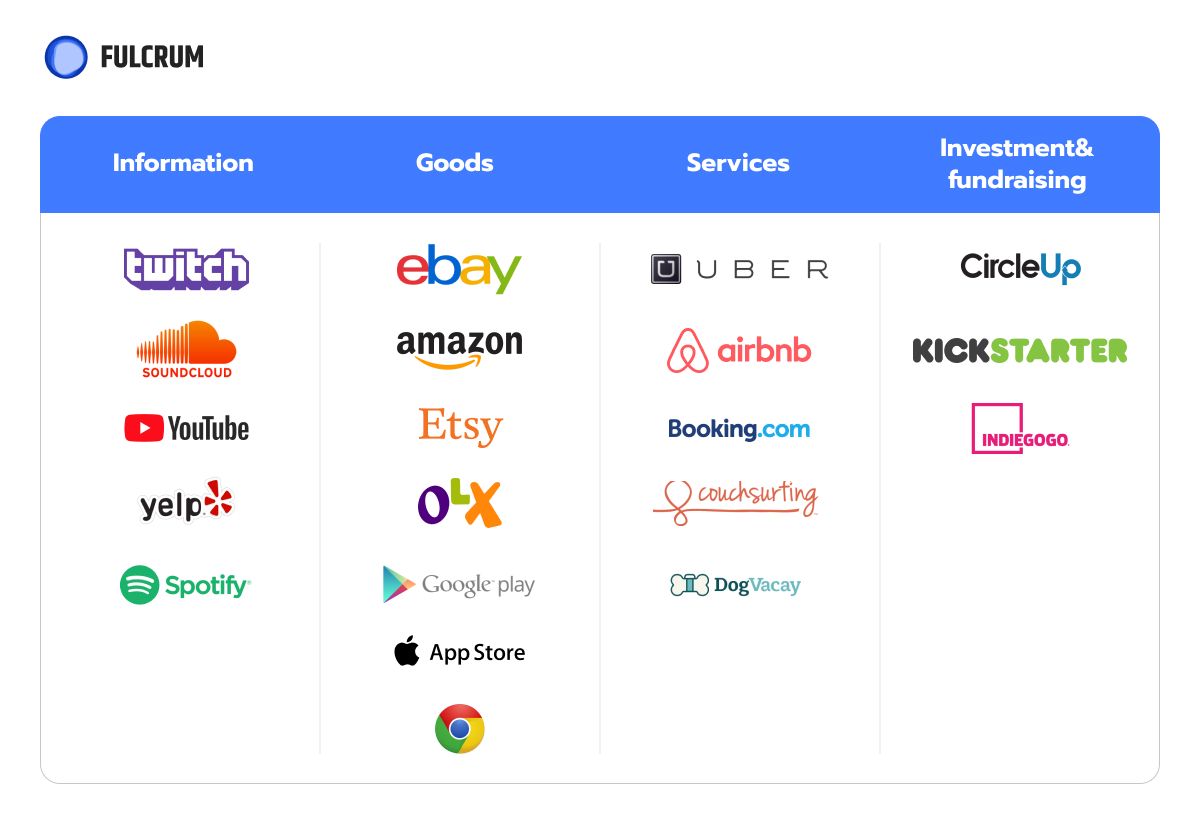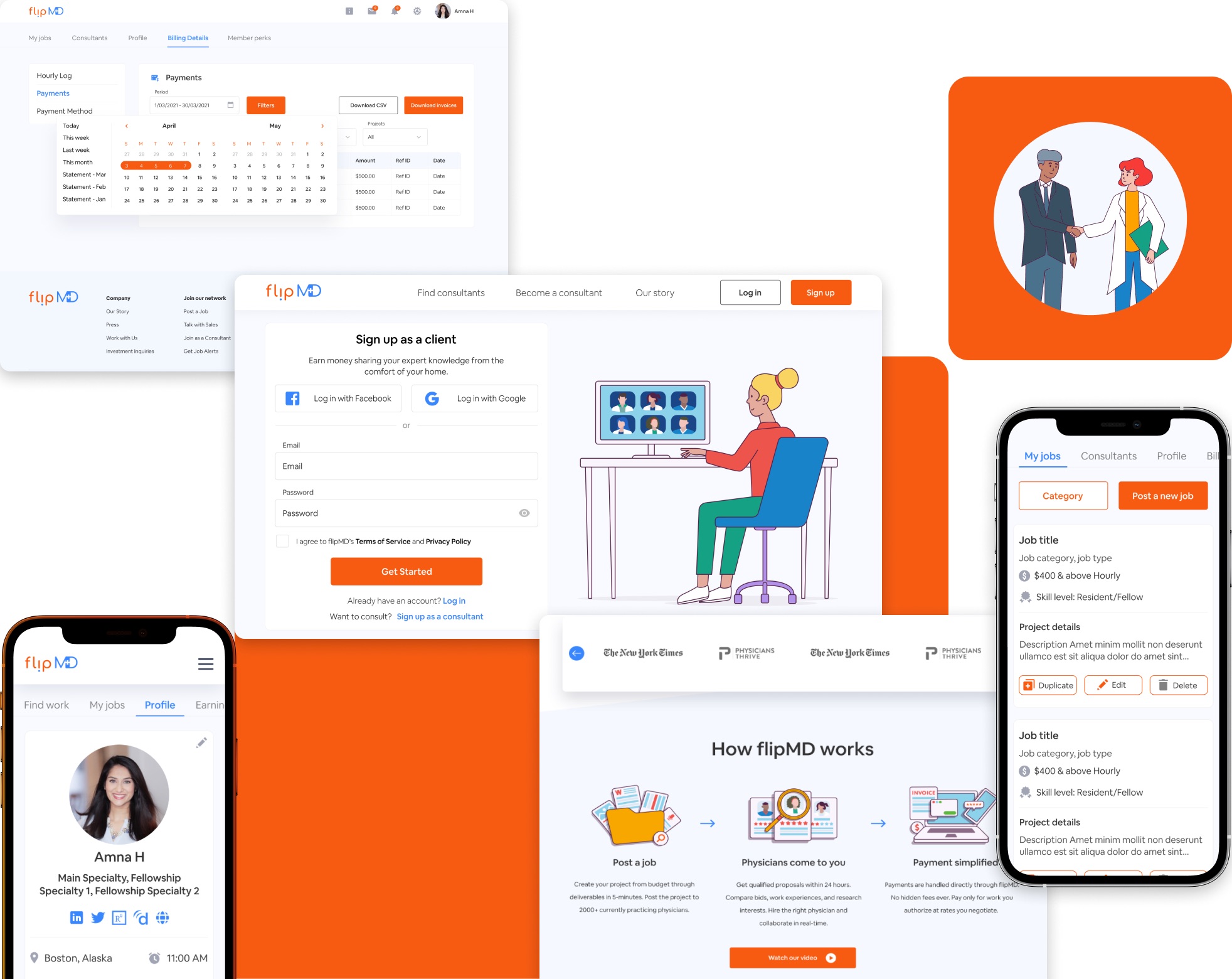Today we’ll tell you in detail how we created the marketplace for physicians.
Marketplaces are divided into a number of types:
- product;
- service;
- information;
- investment and crowdfunding.

Today you’ll learn everything there is to learn on how to create a marketplace of services.
What is FlipMD?
Before we begin our guide on how to create an online marketplace, I’d like to introduce you to our project. All the examples you will see in this article are taken from our work on it.
FlipMD is a Philadelphia-based healthcare startup. Its main goal is to let physicians find consulting opportunities and allow companies to source medical talent. It is an open marketplace of medical professionals offering their consulting services.

Let’s say a company or an individual needs a medical professional. To write an article, conduct a research, process or interpret healthcare data. The company comes to the FlipMD website and finds medical professionals who can do the task. And the medical professionals receive additional income by providing such services with the help of FlipMD.
We rebuilt the old FlipMD website completely. But left most of the existing functionality intact. We added quite a number of custom features to the website. And overhauled the UX and UI. The platform has advanced search, messaging functionality, simple and secure payment, and bookkeeping.
TECH STACK:
- Frontend: Redux, React, Next.js
- Backend: Node.js, Nest, TypeORM, TypeScript, PostgreSQL, Redis, ForestAdmin
Now let’s find out how to create a marketplace website like that from scratch.
The Three Pillars of Any Marketplace – Buyers, Sellers, and Platform
A marketplace website is a platform that connects sellers with buyers. You won’t find a marketplace without one of these three – platform, buyers, and sellers. However, there’s a ton of work to be done before the first line of code can be written. This is where the discovery phase of the software development cycle will help us out.
First we have to determine our niche. To be able to compete with the huge marketplaces like Amazon and eBay we need to choose a smaller, more precise niche. And we have to know our niche and its market from top to bottom.
Before we start building a marketplace we have to understand who our buyers and sellers are. So we research our target audience. Who are they? How old are they? What are their passions? What pains and wants do they have? How do they make decisions?
It is also a good idea to conduct competitor research at this stage.
Only after we have researched everything and found our product market fit do we start actually building our website.
The Logic of Marketplace [Architecture & User Roles]
Another important step to be done before we can begin the actual development is defining the user roles. It is vital to have the roles planned out before the designer starts sketching the first mockup. Before the development team starts planning the platform.

A marketplace is only alive when the users are actively engaging, cooperating, and communicating. So we have to carefully plan out the user roles. And provide each of them with the functionality they need to be able to cooperate effectively.
For example, eBay defines these user roles:
- Registered eBay Users
- Application Developers
- Sellers
- Store Owners
- Bidders and Buyers
For FlipMD we defined these user roles together with our client:
- Guest users
- Clients
- Consultants
- Admins
After we have the user roles determined we need to carefully map out the functionality every role will require. For example, FlipMD guest user requires very limited functionality:
- View main page
- Read about FlipMD
- Check press-releases about FlipMD
- Check info about collaboration with FlipMD
- Watch demo and read FAQ
- Preview ways to sign up in the platform
While a FlipMD client gets a lot more options:
Registration / Sign Up
- sign up using Google / Facebook / email
- login using Google / Facebook / email
- password recovery
- onboarding for filling information
Profile management:
- edit the main profile
- preview the main profile information
- change password
Job posts
- publish/edit/delete a job post
- preview all client job posts
- search a job post
Notifications
- receive notifications (define cases)
- preview all notifications
Consultants listing
- preview all consultants who applied to the job / accept / decline them
- search job post / preview one job post details
- search consultant / preview one consultant page
Communication:
- chat with a consultant (actions in chat should be detailed)
Payment
- pay for the finished job (hourly base / milestone base / fixed price)
- connect a payment card
- Review the transactions history
- review the hourly log
Other
- receive member perks
- invite friends
We write this for every user role. By the end of the process we have the tech requirements for the whole project. Then we brainstorm to find ways to realize it all. This information also helps us choose the best eCommerce platform to create our online marketplace.
Should You Choose CMS or a Custom Development for Your Marketplace?
There are only two ways to do it: either use a Ready-Made CMS or create a custom platform. There are, of course, advantages and disadvantages in both of them.
Pros of Using a Ready-Made Solution for Marketplace:
- Provider’s infrastructure. Most of the ready-made CMSs come with infrastructure from the provider. Things like backups, hosting, deployment, updates are all taken care of.
- Cost. A CMS with default functionality is often completely free of charge.
- Time. If a CMS supports every feature your marketplace needs out of the box, launching your website might be very fast.
- Support and community. If you face an issue when running a marketplace built on a CMS you can always ask for help from the provider’s support team. Or from the community if it’s an open source platform like WordPress.
- Familiar admin panel. If you use WordPress at least a couple of times you won’t get lost in the admin area. And WP is a very popular CMS. Chances are your marketplace admins and users have used it previously. I can’t say the same thing is the case with other CMSs though.
Cons of Ready-Made CMS:
- You’ll need developers familiar with the particular CMS to customize it for you.
- Additional costs. If the CMS doesn’t have the functionality your project needs you’ll have to pay for additional plugins and addons. Or create them from scratch.
- Full control. A marketplace website has to remain operational when there’s high activity on it. If a page loads too long, or a payment doesn’t go through, the client will simply leave. If you don’t have full control over every little piece of the system you can’t guarantee that. And with CMS you don’t have full control.
- Convenience. Not every CMS comes with everything you might need. You’ll have to waste a lot of time finding the right one that comes with every feature your marketplace requires. I’m talking about the themes, plugins, payment options, social networks authorization etc.
- A lot of unnecessary features. A CMS is made to fit a lot of different types of websites. These ready-made engines are usually full of unnecessary modules that can not be removed.
Pros of Creating a Custom Solution:
- Personalization. If we create online marketplace from scratch we make it fit your business goals and requirements precisely. There won’t be any unnecessary features or redundant tabs in the admin panel.
- Security. A custom made marketplace platform has much better security. We have full control over the whole system so we can make it air-tight.
- Scalability. A custom platform can be made scalable from the very beginning. So it will be ready to handle it when your business grows. The growing amount of transactions and the number of customers won’t slow it down.
- No limits on the features. A CMS can have its limits when it comes to the availability of features. A custom made platform has no such limitations. We can make whatever we need.
- Unique design. While a template system is often considered an advantage of a CMS, it is really not an advantage for your business. You want your marketplace to be unique and not look like half the websites on the Internet.
Cons of Custom Development:
- Cost. It might be more expensive than using a ready-made platform. Especially if you won’t require a lot of customization on the CMS. But creating a custom platform doesn’t have to be too expensive. We start with an MVP after all.
- Time. Rome wasn’t built in a day. A successful marketplace was not either. But if your development team is experienced in creating marketplaces from scratch, they have a well tested system. So there won’t be any setbacks.
How to Design a Marketplace
I don’t want to make this article too long so I won’t delve into every detail of the design process. You can check out how we do it at Fulcrum here.
But I’d like to stress the importance of good UX. If your marketplace website has poor UX it is simply doomed. Every user role in a marketplace has to have a simple and logical user area. These user areas have to be different. And the users need to intuitively understand who logins where etc.
We won’t be able to create a truly good UX for such a complex website without an experienced UX designer and extensive UX research.
Another thing worth mentioning – we start designing only after the CMS has been chosen. Why? Because a CMS might have restrictions when it comes to design. And we have to acknowledge these restrictions. Otherwise we’d end up with a useless mockup that can’t be realized into a product. We’d have to start over from scratch and waste the client’s resources.
Roadmap and Project Plan
A roadmap is a visualisation of every step we plan to take when creating our product. This plan of action has to align with the product vision and business goals we determined on the discovery step.
This document is very important. It helps us understand the key elements of our product development:
- the current stage/status of the product;
- its development direction;
- how the goals can be achieved.
A roadmap helps us eliminate the uncertainty about the future. And helps us prioritize and focus on the most important things.
A roadmap usually consists of:
- product development strategy and goals;
- features;
- timeframes;
- highest priorities;
- responsible for the development process;
- status markers & metrics.
Legend for roadmap:
- pink – Frontend development tasks;
- blue – Back-end tasks;
- blue vertical lines – holidays in Ukraine;
- yellow vertical lines – code freezes and regression days.
Every milestone is determined and clearly described BEFORE we start developing the product. If your software vendor doesn’t write the milestones beforehand you have to think twice if it’s really worth working with them. If you need assistance choosing the right vendor to create a marketplace for you make sure to read this post.
Marketplace Monetization Strategy
Finally, when you are working on a marketplace website you have to have a clear understanding of how you will make money with it. There are a number of monetization strategies you can choose from.

Sales Commission
This is the most common way for an online marketplace to make money. A seller pays a predefined % only when they make a sale. This monetization strategy is best for small transactions. Uber and eBay work like this, for example. The platform usually gets a commission fee of 5-15%.
Subscription Fee
Choose this model if you don’t want to depend on the sales volume. Just charge your users a small fee every month or once a year. You can also have different subscription packages. Offer limited functionality for free and the full package for a monthly fee, for example. Or charge only the vendors. Or only the clients. You get the idea.
Listing Fee
If your marketplace has a lot of traffic and active users you can implement a listing fee. A user can place ads for free. If they want their ad to be placed above all the free ads from other users they can pay for the placement.
Pay Per Contact
This is a common monetization model for a service marketplace. There is a fee to contact a customer, while no one guarantees a successful transaction. In this case, the vendor relies on long-term cooperation with the client.
Pay-Per-Action Fee
A pay-per-action revenue model implies the vendor has to pay a fixed amount when a client performs an action. For example, when a user books a table in a restaurant through the marketplace, the restaurant pays a fixed fee to the platform.
Mixed Model
You don’t have to stop at one monetization strategy. Many marketplaces use a combination of multiple monetization strategies. The advantage of the mixed model is that it creates additional value for some marketplace users. While not interfering with everyone else’s work.
FlipMD Monetization Model
FlipMD has a variation of the sales commission monetization model.
For Clients: A 5% Processing Fee is added to the amount funded for each job or milestone.
For Consultants: A 20% Platform Service Fee is taken from the amount funded for the first $1000 with each individual client. Afterwhich, a 10% Platform Service Fee is taken from the amount funded greater than $1001 with each individual contract for the duration of the consultant-client relationship.

Bonus Tip
This article turned out to be quite long. But I couldn’t leave you without this vital tip. Here it is – for every project you work on you have to come up with a Risk and Mitigation Plan.
What will you do if something goes wrong? How will you cope if a key team member leaves the project? What will you do if the development takes longer than you anticipated?
Things happen. And you have to be ready for them.
Conclusion: How to Create an Online Marketplace
Marketplace development is a complex and responsible process that can take up to six months and cost a lot of money. Therefore, before starting development, carefully analyze the niche, determine the trading platform’s strategy and the means of monetization. With the correct calculation, correct marketing, and PR activities, the marketplace’s payback will be from 1 to 3 years, and then the site will work for a profit.
If you need help creating a marketplace website or mobile application for it, please contact us. We already have lots of clients worldwide who relied on us.
FAQ: Create an online marketplace
-
How to Create an Online Marketplace?Here are the most important steps to build a marketplace website:
1) Define your niche and the audience that you will work with.
2) Select the category of goods with which you will work.
3) Decide on the market (b2b or b2c) and the type of business model: classifier, the marketplace, electronic trading.
4) Determine your budget and required functionality.
5) Select your preferred payment solutions.
7) Find the right platform.
8) Build a team of employees.
9) Choose a plan and launch the platform.
10) Create a Minimum Viable Online Marketplace Product.
11) Collect customer feedback and improve your product.
12) Develop and expand your trading platform.
-
How to Create an Online Marketplace Like Etsy?First of all, don't sell to everyone. We recommend that you start slowly following these steps:
1. Analyze your competitors.
2. Define your target audience.
3. Select a monetization model for your marketplace.
4. Write a business plan.
5. Create a design for your website.
6. Don't implement all features that Etsy has. Create an MVP first.
7. Test your website, and receive feedback. The last stage repeat many times by improving your marketplace website and adding new features, etc.
-
How to Create a Marketplace App?Before you pick a reliable development company, analyze and define your requirements for a future marketplace app. Answering these few questions will help you:
1. What pros and cons do your competitors have?
2. What will be different in your app from your competitors?
3. What features should you have in your marketplace app?
4. What features are must-haves on the first stage, and what can wait?
5. What design do you want for the app?
6. What amount of money are you ready to invest in a beta version? After you get all the answers, please find a few development companies, and send them all your requirements. Please, don't hesitate and keep track of the whole development process. Don't forget to test your app to make sure it is targeted correctly. After everything is done, you are ready to promote your marketplace app!
-
Which platform or CMS is Better to Build a Marketplace Website?The most popular are:
CS.Cart
Sharetribe
Cocorico
WordPress/WooCommerce
Opencart IXXO Cart Multi-vendor
Magento
Drupal
Yo! Kart
Shopify
BigCommerce
Arcadier
Prestashop
X-cart Multi-Vendor
To choose which one is the best, you should take to consider your budget and necessary features. We can recommend WooCommerce if you sell digital products.For a multi-vendor marketplace with physical products, take a look at Magentoor CS-Cartplatforms. Sharetribecan be your choice if you want to create a peer-to-peer marketplace.

